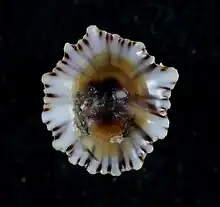| Siphonaria normalis | |
|---|---|
 | |
| Apertural view of a shell of Siphonaria normalis Gould, 1846 | |
| Scientific classification | |
| Domain: | Eukaryota |
| Kingdom: | Animalia |
| Phylum: | Mollusca |
| Class: | Gastropoda |
| Subclass: | Heterobranchia |
| Order: | Siphonariida |
| Family: | Siphonariidae |
| Genus: | Siphonaria |
| Species: | S. normalis |
| Binomial name | |
| Siphonaria normalis Gould, 1846 | |
The False 'Opihi or False limpet otherwise known as Siphonaria normalis is an air breathing sea snail that shares its appearance with true limpets. 'Opihi means limpet in Hawaiian. They are part of the Order of Siphonariidae which are known as false limpets. They live in the mid to upper rocky intertidal zone along the coastlines and can be found throughout the Indo-Pacific regions.
Description
These False limpets have a ribbed shell with a brown and white coloration. They can reach a maximum length of 20mm, but it is usually less than that size in Hawaii.
Reproduction
They lay egg masses, in a spiral formation. When the eggs hatch, the Siphonaria normalis are then in the juvenile stage of their life.
Ecology
Siphonaria normalis or False 'Opihi are grazers that generally consume algae along the rocky intertidal zones. The variety of algae consumed consists of lichens, cyanobacteria, diatoms, microalgae, and foliose macroalgae. As our climate continues to get warmer it causes thermal stress and mortality among the Siphonaria normalis.
Habitat and distribution
Siphonaria normalis has a wide range in distribution throughout the Indo-Pacific. It lives in the rocky intertidal zones along the coastline of these regions. They do not live under the water, but need to be in areas that are wet constantly from the ocean.
Cultural significance
The False 'Opihi was found to occasionally be harvested and consumed by the ancient Hawaiians.
References
- Johnson, Michaela (May 2021). Thermal Tolerance Of Siphonaria Normalis Embryos On O'ahu, Hawai'i (PDF) (Thesis).
- Cox, T.E.; Smith, C.M. (14 July 2011). "Thermal ecology on an exposed algal reef: infrared imagery a rapid tool to survey temperature at local spatial scales". Coral Reefs. 30 (4): 1109–1120. doi:10.1007/s00338-011-0799-2. S2CID 39326740.
- Dayrat, Benoit; Goulding, Tricia C.; White, Tracy R. (March 2014). "Diversity of Indo-West Pacific Siphonaria (Mollusca: Gastropoda: Euthyneura)". Zootaxa. 3779 (2): 246–276. doi:10.11646/zootaxa.3779.2.7. PMID 24871723.
- Cox, Traci Erin; Philippoff, Joanna; Baumgartner, Erin; Zabin, Chela J.; Smith, Celia M. (1 January 2013). "Spatial and Temporal Variation in Rocky Intertidal Communities Along the Main Hawaiian Islands". Pacific Science. 67: 23–45. doi:10.2984/67.1.3. S2CID 85938029.
- Gould, A. (1846). "Siphonaria normalis".
- McCormack, Gerald (2007). "Siphonaria normalis Common False-limpet".
- Field, Julie S.; Lipphardt, Jacqueline N.; Kirch, Patrick V. (1 July 2016). "Trends in Marine Foraging in Precontact and Historic Leeward Kohala, Hawai'i Island". Pacific Science. 70 (3): 287–307. doi:10.2984/70.3.2. S2CID 89436136.